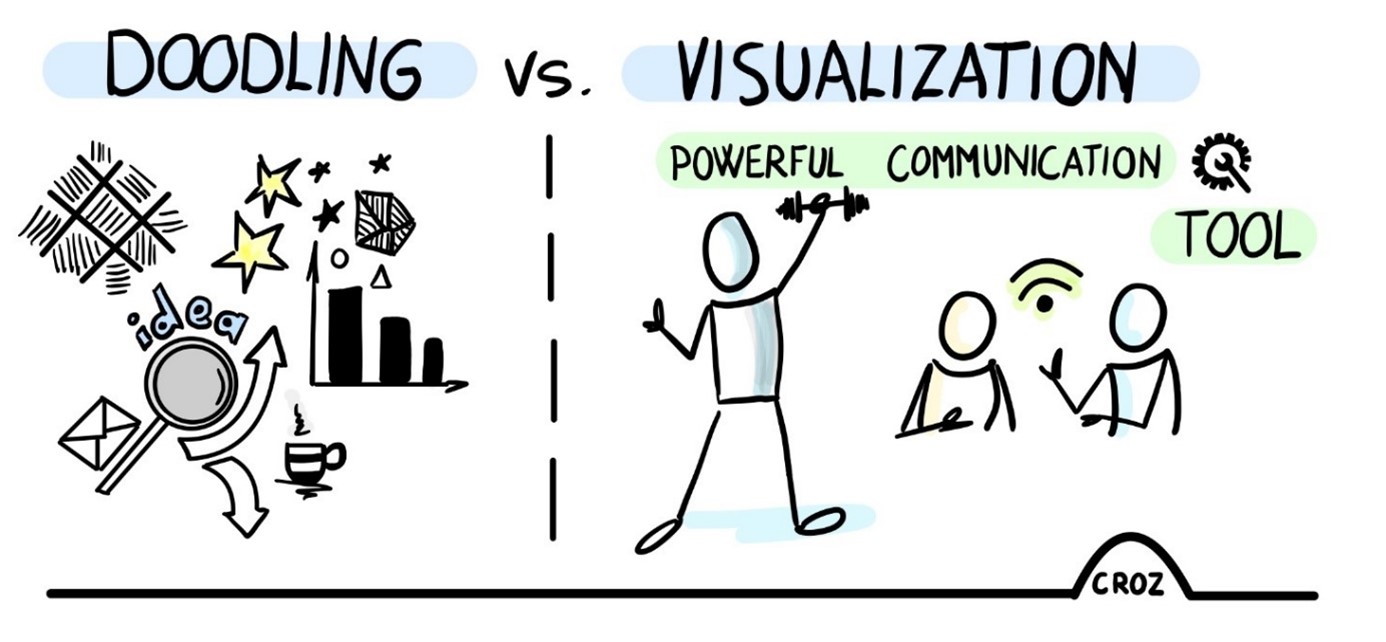We collect so much data today – we do analytics, produce reports, tables, and graphs… All to understand our business and make decisions better. Sure, data is helpful, but how many timeshave you felt overwhelmed by it? How many times have you asked yourself if you really managed to transfer the information you wanted after you’ve finished a presentation with dozen tables or text bullets?
Let’s just take a step back and think for a moment: What is the goal of any communication? Do you ask yourself what do you want the other side to really hear and understand when they walk out the door (or now more appropriately, when they click on the End meeting button)?
That’s what Visual Thinking is all about: transferring information in a very simple way, without redundancy or too many words. The idea behind it is to skip all the unnecessary steps in the communication we usually tend to do and show to the other side what we really wanted to say. Visual facilitation should be a more engaged and fun way to transform information or data into an image. It helps to transfer the key message without too much noise and at the same time, you get very visual meeting minutes no one will forget. With each underlined word or face expression you draw on a piece of paper, you are adding a new layer of communication to the process. Each new layer of communication emphasizes the information and gives an accent to what matters.
Forget about drawing skills, neither how good you are at understanding art. Drawing is just supposed to be a means that helps you in your communication with others, as well as a powerful tool for your own daily visualization of tasks and challenges.
If you ever doodled during a meeting on a piece of paper it means you are already halfway to Visual Thinking. You just need to learn a few tips & tricks (yes, we would love to teach you!) and you are good to go! After that, only the sky and your creativity are the limits.

You can use visual thinking for anything, not only business-related stuff, but we should name a couple of areas where nothing beats visuals:
- Describing situations that involve people with different roles/goals.
- Visualizing tasks/challenges which usually include time planning, project/product roadmaps, and similar. Showing your project roadmap on paper or, even better – drawing it during a meeting with the stakeholders, will be much more effective and explanatory than a standard MS project sheet with milestones.

- Anything related to numbers, graphs, diagrams, directions, especially when trying to show cause and consequence effect, is very easy to put on a picture. You need just a couple of seconds to draw how pieces of your story fit together and emphasize what is important. Of course, you can explain everything, but the picture is what will stay in everyone’s head/notebook after the meeting.
Showing emotions may be very effective with these simple guys.

Get your online meetings to the next level.
Meetings will never die (and they shouldn’t), and it’s nearly impossible to gather people in a room these days to brainstorm and have a meaningful discussion like we used to. So, we have to work with what we have. Including visuals, especially on online meetings, will bring a totally different perspective.
Did you know how easily you can connect your tablet to an online meeting? Through visuals, you can get instant feedback from your audience and much more than that: for example, you can use Mural for a very productive brainstorming with as many participants you want. This is just one part of the tips & tricks that we would love to share with you.
How to get started? With CROZ online Training!
Through our Training, we will teach you how to add visuals to your daily business practice to create more meaningful outcomes in your work. You will learn the importance of simplicity and how to draw a bigger picture that everyone can understand. The workshop is not aimed at developing your drawing skills (but we do draw the whole time:)). Instead, it is primarily focused on how to use visual language to transfer desired information.
Having in mind that visual facilitation is more a need than a luxury only some can afford, we are looking forward to you joining our creative club!
Stay tuned for coming “how to” Blogs that will help you improve your visualization skills !


